Friday, February 27
I Suggest the Christian Thing Would be to Abstain from Mimes
This is the best Zenit Headline ever...This is clearly not what St. Francis meant when he said to only use words if necessary.
"Holy Water, Abstinence and Mimes.""Finally, several readers asked if it was permitted to incorporate mimes and dramas during the reading of the Passion and other Holy Week readings. ..."Err... I'm not sure mimes are ever effective catechetical tools, though maybe things are different in France.
"The liturgy is simply not the appropriate situation for such demonstrations even though they are praiseworthy and effective catechetical tools in other circumstances."
On the other hand, maybe this could be a clever way to sneak the Silent Canon into the new liturgy.
Wednesday, February 25
Matthew Alderman and More at Thomas More College
The Collapse and Restoration of Sacred Architecture in America
In the last half-century, Catholic churches have become proverbially ugly. But today, young Catholics crave not ephemeral plywood and shag carpeting but the timeless signposts of beauty and mystery. Is this a mere shift in taste, or is a deeper cultural conversion at hand?
Join Matthew G. Alderman, New York-based architectural critic and liturgical artist, as he explores the traditional Catholic quest to create the ideal sacred space, what went right, what went wrong in recent years, how Pope Benedict is fixing it, and what you personally can do to help. He will give special attention to the history of the Liturgical Movement, the significance of the Western tradition of iconography and sacred geometry, and the prospects for renewal.
Thomas More College Humanities Room
6 Manchester Street, Merrimack, NH
Friday, February 27, 8 pm.
All are welcome.
Also coming up is a lecture entitled The Restoration of Gregorian Chant in the 20th Century, given by Dr. Sam Schmitt (Ph.D. in musicology from CUA), March 20th at 8:00pm at the College.
Monday, February 23
More Photos of St. Leopold's, Steinhof
Friday, February 20
Another Daily Dose of Cram

The Bethany Home Chapel, intended as the oratory for an Anglican sisterhood, though the details are somewhat scarce. A handsome, simple design that could very easily be adapted for a small contemporary parish, in the right hands, naturally.
Sea-Monkeys of Old Russia
Our Orthodox readers and fans of Father Vasily in particular will be interested to know that it seems brine-shrimp have been a popular childhood let-down since tsarist days, as we read in Orlando Figes' intriguing cultural history of Russia, Natasha's Dance, in an account quoed from Mikhail Zernov, which also mentions an ancestor of another simian childhood disappointment, the sock monkey, which, according to Wikipedia, 'hold an important place in the culture of North America as a symbol of ingenuity.' Unsurprisingly, a citation is lacking for the last statement, which puzzles and alarms me. But, as I was saying:
On the eve of Easter, Moscow broke out of its ordered service and a screaming, raving market opened on Red Square. [...] We went every year to take part in this traditional Moscow celebration with our father. Even from far away, as you approached Red Square, you could hear the sounds of whistles, pipes and other homemade instruments. The whole square was full of people. We moved amid the puppet boths, the tents and stalls that had appeared overnight. Our religious justification was buying willow branches for the All-Night Vigil to mark Jesus's entry into Jerusalem [a substitute for palms one finds in some colder western-rite countries]. But we preferred the other stalls which sold all kinds of weird and useless things, such as 'sea dwellers' living in glass tubes filled with colored liquid, or monkeys made from wool. There were colorful balloons with wonderful designs, and Russian sweets and cakes which wer were not allowed. Nor could be go to see the woman with moustaches, or the real mermaids, or the calves with a double-head.So, say it loud, 'Was it fancy capitalist sea-monkeys in 19th century Russia?! Yes, it was!' Also, I think Passiontide would indeed be quite lively if we had bearded ladies in the Western Church as well.
Next week--the secret Carthusian origins of the mail-order submarine.
Thursday, February 19
Kirche am Steinhof, Vienna
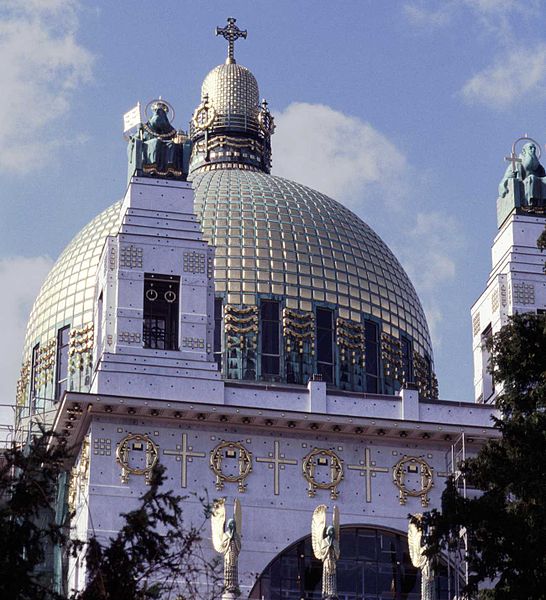
Otto Wagner's architecture manages to combine aspects of nearly every type and style of architecture I enjoy. While his architectural theories contained hints of structuralizing modernism, his built projects almways managed to stay, however simplified, within an aesthetic that seems quite traditional to our eyes today. In spite of approaching church architecture largely as an exercise in pragmatics rather than as a spiritual exercise, one of his finest masterpieces was the quite remarkable Kirche am Steinhof, St. Leopold's, the chapel of the old Lower Austrian state hospital for the insane, now known as the Steinhof Psychiatric Hospital. Built 1903-1907, it includes interior work by the Viennese decorative artist Koloman Moscher in addition to Wagner's architecture. While practical concerns remain foremost (the pulpit is designed in such a way to protect the priest from inmates running amok), it is nonetheless a stunning design, conveying a cultured modernity that might have been, and which did not need to sacrifice a sense of history, time and place to succeed.


Wednesday, February 18
Holy Cross, Sedona

As most of our readers know, I am not terribly fond of modernist architecture. Nevertheless, there are some rather crisp "porthole moderne" examples from the thirties that I don't mind (perhaps out of nostalgia for old PBS airings of Poirot), and I'm rather fond of a good bit of Frank Lloyd Wright's work. These tend to have at least some touches of traditional design and craftsmanship, however obscurely lingering. One more purely modernist design that I find of note if not necessarily completely beautiful is the Chapel of the Holy Cross in Sedona, done by one of Wright's disciples. I'm not sure whether it's the pre-Conciliar layout, the stunning surroundings, or its intimate size, but it is not without a certain appeal, if in a super-Cistercian, pared-down sort of way. It is, like all modernistic buildings, a bit diagrammatic, but it nonetheless offers food for thought. More here.
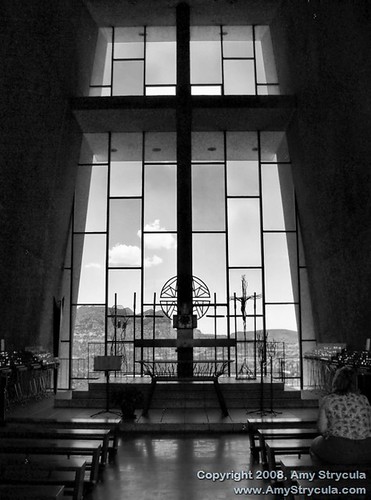
Your Daily Dose of Cram and Goodhue...
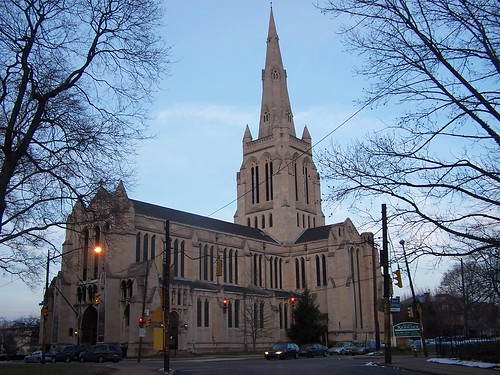
...can be found over at this rather fine Flickr set, which focuses on some of their work in the Pittsburgh area, including one of my favorites, East Liberty Presbyterian; Cram supposedly told the client that it would be "so gothic, Mrs. Carnegie wouldn't be able to sleep nights." (You can find it here.)
In the same vein, this weblog looks potentially quite interesting.
Tuesday, February 17
An Architectural Fantasia
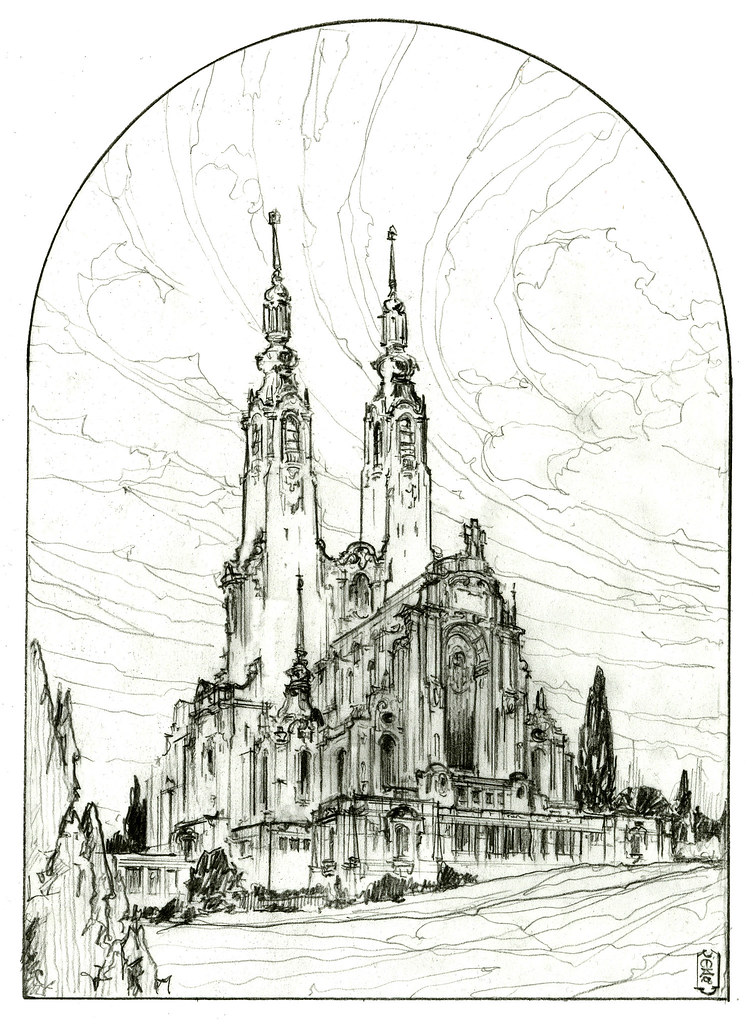
Matthew Alderman. Architectural Capriccio in the Form of a Cathedral for Steubenville, Ohio. Pencil. 2008.
Does No One Think About The Way This Stuff Sounds?
Welcome, First Things Readers!
This is the Shrine of the Holy Whapping, a group blog which the four (or five of us, if you include our emeritus member) started back when we were all at Notre Dame, and which has continued in the three or four years since we got out into the real world. (Don't ask about the name, it's a long story involving music and sound-effects). Dan is our resident theologian/postmodern fast-food, hymn-singing expert, Drew our cuckoo-clock expert, Emily our official churchlady/Latinist/fashion and homeschooling consultant, and Becket the man of mystery, because I have no idea where he's gone off to. I think we might have left him back two or three rest-stops.
I handle architecture, art (much of which I produce--I take commissions, incidentally), art history, obscure saints, dead European royalty, Alexander Hamilton, and long posts nobody ever finishes reading, despite all the time and effort put into them. Not that I'm complaining. I'm a New York-based graduate of the University of Notre Dame School of Architecture, who occasionally designs church furnishings, undertakes commissions for liturgical illustration, and, as a critic, sometimes writes articles on architectural matters and more for the Catholic press. (My first scholarly article, "Heaven Made Manifest" appears, complete with illustrations by the author, in the 2008 edition of Antiphon, as well.)
I've even given a few lectures on the subject--my latest, if you're in the area, will be at Thomas More College in Merrimack, NH, on February 27 at 8 PM and will be titled Why Does Our Cathedral Look Like a Sam's Club? The Collapse and Restoration of Sacred Architecture in America. In it, you'll find out what went wrong in recent years, how Pope Benedict is fixing it, and what you personally can do to help. I also occasionally post over at the New Liturgical Movement and Small Pax, as well as helping edit and contributing to the literary magazine Dappled Things.
Pretty much just about anything can happen here on the Shrine, from long, drawn-out binges of self-referential Catholic Nerd humor to more serious (really) poetry and travelogues from my days studying in Rome, serious architectural criticism, gossip about long-ago Hapsburgs, and some things I'm not sure even we can classify. (Like this). Browse through the archives, and come back for more tomorrow!
Three New Illustrations
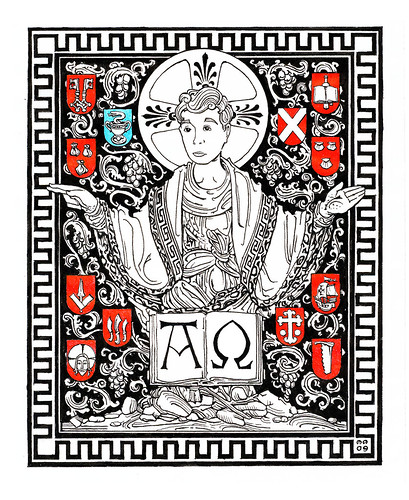
Matthew Alderman. Christ the True Vine. January 2009. Private Collection, California.
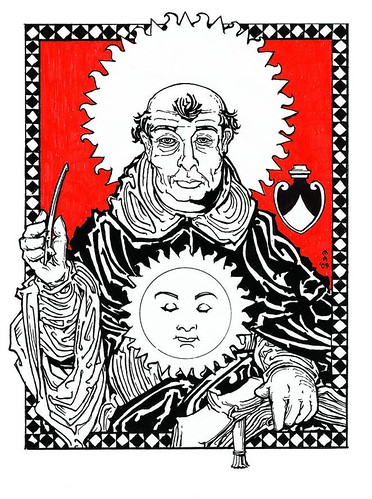
Matthew Alderman. S. Thomas Aquinas, Patron of Students. (Illustration for an Ex libris). Ink on Vellum. February 2009. Private Collection, Washington, D.C.
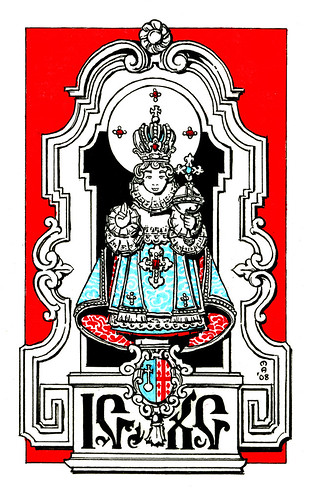
Matthew Alderman. The Divine Infant King of Chicago. Commissioned to celebrate the raising of the Institute of Christ the King, Sovereign Priest to a Society of Apostolic Life of Pontifical Right. November 2008. 4" x 6," ink on Vellum. Private Collection, Alabama.
Monday, February 16
Apropos of Nothing

I was recently sent a link to a gallery of beautifully-designed provisional local currency notes used in Germany during the financially unstable era of the Weimar Republic, that wobbly, uncertain period of democratic experiment between the Hohenzollern collapse in 1918 and the rise of Nazi tyranny in the early '30s. During this period, it appears, different towns and even companies hired artists to design currency to provide a certain stability to their workers and residents in the midst of, at various points, deflation and inflation. While I doubt they were worth much, they do show the startlingly good and bold quality of graphic design during the first part of the previous century, and that, in contrast to the hallucigenic-looking new bills being put out by the Treasury Department, adding color doesn't mean making something look like play-money. I mean, honestly, some of the new-ish watermarks look like Schoolhouse Rock cartoons.






Why Custom, Tradition and Manners Matter
--Edmund Burke
Theology on Whap
12:00-1:00 AM Classic Theology on Tap: Broadcast live from last call at the Bishop Caroll Microbrewery, the papist alternative to Sam Adams.
1:00-2:00 AM Theology on Map A televised debate between St. Virgilius the Geometer, Sir Bedevere from Monty Python and the Holy Grail, and the Nestorian Cosmas Indicopleustes (author of the flat-earth text Topografia Christiana) on whether the world is round, shaped like a banana, or shaped like a cuboid tabernacle.
2:00-4:00 AM Theology on Cap. Infomercial. St. Philip Neri models the latest novelty zuchetti taking the Roman curia by storm. Imagine, a biretta with "Who, me, worry?" written across the front can be yours.
4:00-5:00 AM Theology von Trapp. Today's installment: steel-cage grudge-match between Julie Andrews and Bishop Williamson, followed by a discussion of the Council of Ephesus in a segment entitled "How do you solve a problem like Maria?" Then, a roundtable discussion on the "search for the historical Baron von Trapp," and we will conclude with the singing of the Austro-Hungarian National Anthem and a round of tokay.
5:00-6:00 AM Theology on Sap. Your morning dose of pious treacle from the Really Adorable Little Sisters of the Fuzzy Paschal Lamb of Stowe, Vermont, this time reporting live from the field as they start out this year's annual maple syrup harvest. Be prepared, there's a lot of lace on their altar-cloths.
6:00-7:00 AM Theology on Tap (Shoes). Unfortunately, pre-emtively anticipating the new fairness doctrine expected to come down on high from Washington means broadcasting this documentary on liturgical dance. Just remember, "You are the jazz hands of Christ."
7:00 AM-9:00 AM Theology on Zap. Today, on everyone's favorite wacky drive-time astronomy show from the papal observatory, Fr. Gabriel Funes interviews special guest Morbo the Annihilator on what to do if attacked with an alien ray-gun. The answer? "Not much you can do, puny humans."
9:00 AM-10:00 AM Theology on Cab (Calloway). You'd be amazed at how much exegesis you can get out of the lyrics to Minnie the Moocher if you squint. Hi De Hi De Hi De Hi.
10:00 AM-11:00 AM Theology on Tap: The College Years There are few more disturbing combinations than Catholicism, alcohol, and Dustin Diamond.
11:00 AM-12:00 PM Theology on Tap: The Next Generation. Live from the deck of the papal space galleon Enterprise.
12:00-2:00 PM Theology on Nap. Today, the friars of Our Lady of Perpetual Sloth celebrate their customary post-lunch devotions in honor of the Dormition of the Blessed Virgin. (Hey, if there was an order known as the "Sleepless Monks" in the Byzantine Empire, someone presumably had to take up the slack somewhere.)
2:00-4:00 PM Theology on Rap. We're not sure but we suspect this involves the Franciscan Friars of the Renewal, pontifical bling, and extreme skateboarding. Just a hunch.
4:00-5:00 PM Theology on Yap. Fr. Damien de Veuster runs into a problem on his visit to the small Pacific island of Yap, known for its twelve-foot-wide diameter stone coins, when, while paying his bar tab, the tender can't break a twenty.
5:00-6:00 PM Theology on Tap: Criminal Intent. When we said "Car Bomb," we meant Guiness, Irish Cream, and Jameson's, Mulroney. Now, begorrah, look at the mess ye've made.
6:00-7:00 PM Theology on Lapp As an ecumenical gesture to our Lutheran pals, we're broadcasting our favorite Scandinavian cooking show, broadcast tonight live from Västernorrland and featuring an exotic fusion recipe of reindeer meat and cream of mushroom casserole.
7:00-10:00 PM Theology on Tap: St. Blog's Edition Fr. Z. treats us to the original Latin, pre-ICEL version of 99 Bottles of Beer on the Wall, while the Recovering Choir Director renders it in ancient Cistercian chant. Matthew and the NLM team attempts to turn the bar into a reproduction of a Maltese basilica with some strategically-placed wall-hangings.
10:00-11:00 PM. The Revelation of the Sacred Mysteries to Tender Minds Within the Confines of a Secular Establishment Serving Dionysiac Libations (Working Title: The Ouzo Hour) Originally intended as a pilot episode for an Eastern Orthodox version of the series, unfortunately it collapsed into chaos after Fr. Vasily discovered there was no 19th century Russian vodka available. Is outrage!*
11:00-12:00 PM The Venerable Matt Talbox Detox Hour. Because, face it, guys, I can't tell by now if I'm seeing the Two Natures of Christ or just double. Let's get some coffee.
*There was also going to be an ecumenical Catholic-Protestant-Jewish version, A Priest, a Minister and a Rabbi Walk into a Bar, but it degenerated into an argument between the relative merits of whiskey, Mogen David and unfermented Concord grape juice.
Sunday, February 15
Cum molestia notatur
The early Church certainly had a conception of "full" and of "partial" communion.
In his book Corpus Mysticum, Henri Cardinal de Lubac notes, "first of all there was simple communion, which comprised only communion in prayer or at most comunion in the offerings, which entailed admission to the ceremonies of the Church, then, subsequently, full or perfect communion, which in addition consisted of full sacramental reception of the bread of Christ: the sharing in the mysteries or sharing in the bread." (cf. Ambrose, In Lucam, 7, n. 232; Fulgentius, ep. 12, n. 26).
To quote a primary source, St. Augustine, one of the four fathers of the Western Church, writes that the Donatists are "in communion" with the Catholic Church insofar as they agree with the Catholic Church, and "out of communion" with the Catholic Church whereever they disagree with the Catholic Church. Communion with the Church, Augustine teaches, is a spectrum.
Thus, we read in On Baptism, Against the Donatists I:1,
If, therefore, a man who has severed himself from unity wishes to do anything different from that which had been impressed on him while in the state of unity, in this point he does sever himself, and is no longer a part of the united whole; but wherever he desires to conduct himself as is customary in the state of unity, in which he himself learned and received the lessons which he seeks to follow, in these points he remains a member, and is united to the corporate whole.
As you'll find out if you read the whole work, knowingly separating yourself from full communion, Augustine teaches, has eternal consequences. But, separation from full communion still entails partial communion.
So, the next time that you're skipping off to Mass, and a voice from a dark alley calls out, "hey little kid, wanna learn how there's no such thing as partial communion?", make Nancy Reagan proud. Just say no.
Saturday, February 14
World Wrestling Euno-mania (WWE)

Actual Eunomian
Around AD 378, St. Gregory of Nazianzus preached his great Theological Orations against the Eunomians, showy Arians who denied the divinity of the Holy Spirit.
He warned:
"They are like the promoters of wrestling-bouts in the theaters, and not even the sort of bouts that are conducted in accordance with the rules of the sport and lead to the victory of one of the antagonists, but the sort which are stage-managed to give the uncritical spectators visual sensations and compel their applause." (27:2)
(from a superior translation to that linked above)
Ultimately, the Eunomians lost for the same reason as the Pneumatomachi--the Holy Spirit can't be taken down with a folding chair.
Happy Valentine's Day from the Onion
By St. Valentine
February 10, 2009 | Issue 45•07
Is it Valentine's Day already? My word! How the time does fly. I might have missed the day entirely had I not caught a glimpse of all the young couples walking hand in hand this evening, filling the tables of every fancy French restaurant in town. And what better way to celebrate this fine holiday than sharing a scrumptious, fixed price, three-course menu with your beloved? Lord knows that's what I'd be doing tonight if my head hadn't been severed from my body in the third century!
Read it all
And from the Shrine,
Happy Valentine's Day to the couples, and happy Cyril & Methodius to all!
Holy Whapping Hurray for Fr. Robert Barron
As part of this work, Fr. Barron has prepared a 10-part series introducing Catholicism. Here is the preview:
Catholicism Trailer from Nancy Ross on Vimeo.
Hat tip to Cardinal O'Malley
Fr. Barron has also written what looks to be an interesting new book, which I have yet to read:

The book is on sale at Amazon for $27.00 new, but around $10 second-hand.
If anyone has read the book, please feel free to comment.
Um, gulp?
Friday, February 13
From the Pen of Bertram Goodhue
A handsome rendering of All Saints' Parish, Brookline, Massachusetts (Cram, Wentworth and Goodhue, 1894; an addition was dedicated in 1926)
Cardinal Consalvi's Laying-in-State, 1824
"The population of Rome poured out for the last sad ceremonies and the traditional homage. Consalvi lay in state for a week in the Caracci Gallery of the Palazzo Farnese, the most beautiful room in the world. Arrayed in his scarlet cardinal's robes, of which he had been deprived by Napoleon, his many-tasselled hat, the first to have been bestowed by Pius VII, at his feet, he lay on a catafaque surrounded by sixty-six candles, one for each year of his mortal life. His body was embalmed in accordance with the rites of the Sacred College; his face covered by a wax max modelled by Thorwaldsen, the greatest living sculptor in Europe, who could scarcely do his work for the tears. 'The crowd pressed by to contemplate and to pray beside the spectical of the Christian apothesosis of this great man of the world.' "
Sanctoral Curiosities
Amphibalus (St) June 24
? The supposed fellow-martyr of St. Alban of Verulamium. In the original Act it is only said that St. Alban put on the priest's cloak (amphibalus) and was arrested instead of the priest who had taken refuge in his house--not with the priest. Geoffrey of Monmouth took the word amphibalus to be the name of the priest.
Bean (St) Bishop, Oct. 26
d. p. 1012. Bishop of Mortlach in Banff [in Scotland, not Canada], from which see he was later transferred to Aberdeen.
Bobo (Beauvon) (St) Hermit, May 22
d. c. 985. A knight of Provence, who [...] as a hermit to lead a life of penance. [...]
Brychan (St), April 6.
Nothing is known for sure about his life, but in legends he is a saintly king in Wales with a large number of saintly children: the usual quoted number is twenty-four. Other saints are meant to be descendents of him in later generations such as Enoder [...] [Some accounts expand the number to a whopping twenty-four sons and twenty-four daughters, doubtlessly a conflation of grandchildren and great-grandchildren with their number!]
Gonzaga Gonza (St) Martyr, June 3
d. 1886. Having spent a long time in prison, he was put to death by King Mwanga of Uganda. [...]
Grwst (St) Confessor
7th cent. The Welsh saint whose memory is perpetuated by the placename Llanwrst, Clywd. [Pronounced, "Huh?"]
Gwynllyw (St) Hermit, March 29
d. c. Gwynllyw is anglicized as Woollos. He is said to have been the husband of St. Gladys [daughter of St. Brychan, apparently], the father of St. Cadoc, and to have ended his life as a hermit in Wales. [...]
Lucius (St) King, Dec. 3
? d. c. 200. King of Britain. According to a tradition, first heard of in the sixth century, he asked Pope St. Eleutherius (d. c. 189) to send missionaries into Britain [...]. Present-day historians regard the whole story as fictitions: it is in fact based on a confusion with the story of Agbar IX, who was king of Edessa in Mesopotamia. He was also known as Lucius; and he sent to Pope St. Eleutherius for missionaries [...].
Lucy Brocolelli (Bl) Virgin, Tert. OP., Nov. 15
1476-1544. Born at Narni in Umbria, [ie, the town known to the Romans as Narnia. Hence Bl. Lucy of Narnia...]
Manez (Mannes, Manes) (Bl) Confessor, OP., July 30
d. 1230. Manez de Guzman, an elder brother of St. Dominic, was born at Calaruega. He joined the original sixteen members of the order of Preachers in 1216, and later was prior of St. James's in Paris [...]
Quadragesimus (St) Confessor, Oct. 26
d. c. 590. A shepherd and subdeacon at Policastro who, according to the testimony of St. Gregory the Great, raised a dead man to life. [Okay, here it's just interesting his name sounds kinda like the Latin word for "Lent."]
Thursday, February 12
Lee Lawrie, Architectural Sculptor
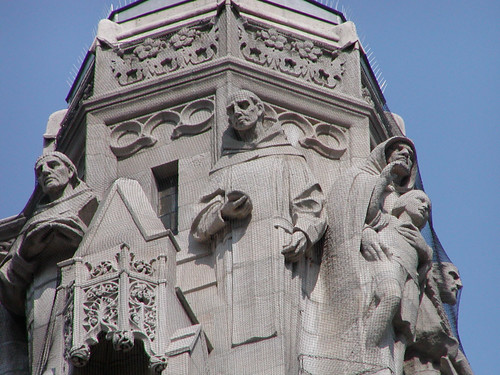
Lee Lawrie was one of the finest sculptors of the first quarter of the twentieth century, and a major force in the Art Deco of the period. He is particularly connected with some of Ralph Adams Cram and Bertram Goodhue's various works, having sculpted the masterful reredos of St. Thomas Church and some of the exterior work on St. Vincent Ferrer, both in New York. Largely and unjustifiably neglected by scholars until recently, he finally has his own flickr.com group, so go have a look round!
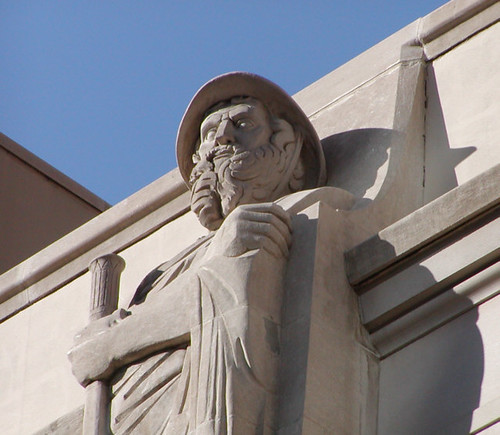

Jerusalem the Golden

The competition for New York's Episcopalian cathedral, St. John the Divine, saw many flamboyant entries, such as Carlo Sada's fanciful proposal for a 1,200 foot tall "skyscraper church" which would have overtopped the Manhattan skyline, as well as most tall buildings in the world at the time. Others, featuring a crossing bristling with four separate towers, resemble an interesting cut-and-paste Photoshop accident, and a few fairly handsome efforts in a classical style challenge our retrospective notions of the absolute supremacy of Gothic during the period. There's even one ambitious if awkward astylar effort by the adolescent Goodhue, precocious, if perhaps not having hit his stride quite yet.
One truly wonderful--and slightly hallucigenic--standout was W. Halsey Wood's proposal, titled Jerusalem the Golden. It is filled with all manner of recondite symbolism and extravagant touches, such as a great organ, a choir organ split up between the two towers, and at least eight or nine lesser organs placed over the entrances to the apsidal and even the nave chapels. The dazzling display of mystical symbolism was a bit too much for the earthbound press to appreciate, who, at one point panned Wood's elaborate reckonings of his numerical iconographies, wondering amid all these tribes, apostles and angels, what was actually going to hold the building up. (To give a sense of the massiveness of the structure, the choir itself would have been seventy feet wide, one hundred and thirty-five feet long, and contain one hundred and fifty stalls to each side.)
Wood's symbolism was hardly caprice. He ended up submitting a plan carefully annotated with the relevant lines from the Apocalypse of St. John which motivated his design choices. (He was not alone--the winning design, a rather inoffensive exercise in Byzantinized Richardsonian Romanesque by Heins and LaFarge, which was later abandoned in the middle of construction, was equally encrusted with symbolism, though not without some odder touches: "Seated statues at the peaks of the great gables represent great teachers of mistaken religions, Buddha, Muhammed, and Confucius being thus subordinated to the more perfect Christian faith." (I suppose, in retrospect, it is no more heterodox than the be-haloed Aristotle in one of the windows of St. Vincent Ferrer about forty blocks to the southeast, even if somewhat more peculiar.)
Some aspects of the design are a little strange--the rather weak articulation of the principal elevation behind the low screen of the narthex; the wealth of freestanding or nearly-freestanding towers, the stumpy nave swallowed up by the great crossing; but many of these are simply traceable to the titanic scale of the project, a feature common to every one of the designs submitted. In some respects, it was as much a skyscraper church as the Sicilian Sada's proposal, if perhaps in greater continuity with the past. Indeed, as centralized and upright as the design appears, in plan it rather resembles San Marco in Venice, and preserves a clear sense of liturgical directionality within the interior, even if tempered with the functional emphasis on preaching characteristic of American Episcopalianism at the time. It was undoubtedly the most creative, innovative and imaginative proposal, and deserved its moment of glory, though it never came.
Wood's failure devastated the man, and he died shortly thereafter. His few built works are, by comparison, fairly conventional examples of the period. His massive central tower, covering the congregational space close to the pulpit, is thought to have influenced Goodhue's proposal for St. Bartholomew's Church, which featured a prominent "ciborium," or high dome, which was unfortunately not completed as originally designed. In both, it represented an interesting--and fairly successful--attempt to coherently articulate, at least according to Christine Smith in her account of St. Bart's construction, a "low church" theology of divine immanence in the lavish artistic terms usually restricted to "high church" expressions of God's transcendence. Today, fixated as we are on the gypboard-lined House of the People of God, it is interesting to see that even this communitarian view of the liturgy, whatever theological concerns we might have about its neglect of the sacrificial aspects of traditional worship, at the very least need not be ugly, a-hierarchical or architecturally incoherent.
Cram wrote in 1936 that Wood, had he survived, might have been "potentially one of the great architects of modern times," commenting further that the design was "simply astounding... had it been built it would, I am persuaded, have marked an era in the development of American architectural style.... Visionary - impracticable and fantstic if you like, wholly original and combining instinct with tremendous vitality, it represented an emotional impulse that, I believe, could easily have been given a rational practicality if only the ecclesiastical authorities of the time had had the imagination and the courage to see their opportunity and avail themselves of it."

Noli me tangere

Two details from a rather charming window of the Noli Me Tangere by Martin Travers, the inimitable designer of Anglo-Catholic Congress Baroque--as well as a fair amount of Gothic and a a little that is almost unclassifiable. I particularly like the mix of simplicity, stylization and ornament characterizing the figure of the Magdalene, whose expression is somehow graceful, womanly and childlike all at once.
I Think They're onto Me
Friday, February 6
Frank Parater, Servant of God

Tomorrow is the commemoration of Frank Parater, a seminarian from Richmond, Virginia who died on this day in 1920. Chiara, one of his strongest devotees, has a commemorative post.
A Double Happiness
But, happiness, the Benedict XVI did commemorate Holocaust Memorial day, and I can share that with you here:
Double happiness, the Vatican YouTube channel now allows embedding. : )
Double and a half happiness, we get decent view of the Paul VI Audience Hall which--my secret shame!--I am quite found of.
Beloved...
Whoever acknowledges that Jesus is the Son of God, God remains in him and he in God. We have come to know and to believe in the love God has for us. God is love, and whoever remains in love remains in God and God in him. (1 John 7-8, 15-16)
Readers know we have an affinity for reinterpretting pop songs according to a Christian hermeneutic.
I have to say that I really like this song from Incubus. And, it definitely expresses the paschal nature of Christian love--"love hurts; love stings, when it transcends the bad things."
Or, the opening lines--think Psalm 42 (43)!
Deum, qui laetificat iuventutem meam, confitebor tibi in cithara! Deus, Deus meus!
I think "cithara" can reasonably be rendered "guitar" :-)
Wednesday, February 4
Holy Name Cathedral Updates

Firefighters sweep water from the floor inside Holy Name Cathedral in Chicago Wednesday after an early morning fire severely damaged the attic and left gaping holes in the roof of the 134-year-old landmark and seat of Cardinal Francis George.
(Source: AP Photo/Chicago Sun-Times, Brian Jackson)
As you can see, the ceiling woodwork, along with the rest of the interior remains largely intact. The only visible damage in this photograph is the column to the far right. It remains to be seen how much structural damage occurred today.
More photos here.
Chicago Breaking News: Holy Name Priest to the Rescue
The Scene Inside Holy Name Cathedral:The Rev. Matt Compton woke up to turn the light off around 5 a.m. and heard sirens near the cathedral's rectory. He thought the fire trucks were headed to a nearby condominium and office building - but then he saw a firefighter unrolling a hose and heard another say, "No, it's the church."
He sprung into action.
Compton put his boots on, grabbed his coat and rushed into the church. He directed firefighters to a southwest stairwell that led into the attic above the cathedral's decorative ceiling.
In the cathedral, water poured from the ceiling as the firefighters began battling the flames.
"It almost appeared as if it was raining in the cathedral," Compton said, adding that it smelled like "burning wood, like a fireplace."
Icicles formed on the edges of the pews, and patches of ice covered the floor.
The Rev. Daniel Mayall, Holy Name's pastor, was matter-of-fact as he pointed to where pieces of a pillar had peeled off. Earlier in the morning, a waterfall had streamed down the pillar."There's no other visible damage except that," Mayall said. "Everything else looks like it did yesterday."
In the sanctuary, five galeros -- red ceremonial hats with tassels that belonged to former cardinals -- still hung, apparently soaked but intact.
Chicago Cathedral Fire
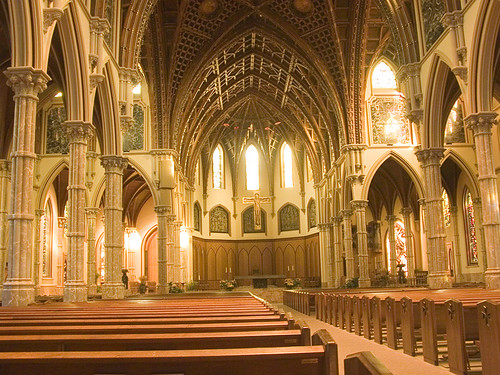
This isn't exactly breaking news at the speed of the internet, but in case you, like me, are just getting to your computers today, there was a fire at Holy Name Cathedral this morning. The fire damage, though severe, seems to be mostly in the recently-renovated roof, and those who are familiar with the cathedral will recall its ceiling (above) as one of its most striking architectural aspects. As I'm reading updates, it appears the water damage, in particular, is quite extensive. It is a great loss, to be sure, and the Archdiocese of Chicago is in our prayers this morning.
UPDATE: The AP has a more current and extensive report on the damage.
Like the Hokey Pokey, I Didn't Realize it Had to be Invented*
*In re the hokey pokey (written by British bandleader Alan Tabor), it appears to have nothing to do with mocking Transubstantiation, contra Catholic urban legend. (Remember, the Canon used to be silent, and still is in certain Forms). So, homeschoolers, at your birthday parties, put your left hand in with abandon!
Pontifical Product Placement

Bovril, like that English delicacy Marmite and fried Mars bars, is one of those famously bizarre foods that simply fails to appeal to transatlantic tastes. (It cuts both ways, I assume, and there are probably Londoners baffled by our own enthusiasm for dayglo-colored icees drunk out of gallon jugs, though to make sense of those one must remember they exist mostly to provide exuses to hit rest-stops on those otherwise interminable western roadtrips.) It's a salty beef extract that can be turned into a hot drink, spread on toast, or used in soups, and takes its name from bos, meaning "ox" or "cow" in Latin, and the made-up word "vril" used in Edward "It was a dark and stormy night" Bulwer-Lytton's hokey 1871 "lost civilization" novel The Coming Race (about subterranean supermen descended from frogs who use the mysterious power called Vril to do...something-or-other), which, mistaken for nonfiction by theosophical cranks, has been the subject of fringe theories about Atlantis and Nazi UFOS, and may have inspired Nikola Tesla to invent remote control. (Tesla, incidentally, is also sometimes blamed, on no real evidence, for the Tunguska explosion, primarily because if it's weird it must have something to do with him.)
Bovril, also, as Ex-Laodicea reports:
was invented by a British businessman as a hearty drink for the soldiers of Napoleon III during the Franco-Prussian War. So, in a certain sense its original function was to preserve the Papal States. (It was the defeat of Napoleon III at the battle of Sedan which led to Piedmont’s annexation of Rome in September 1870). Furthermore, true to its Papal origins, an advertising campaign of ‘the early twentieth century’ (Wikipedia) boasted that Bovril, like the Pope, possesses an infallible power! In the case of Bovril presumably the power is to keep you warm at football matches, as it doesn’t seem to be much use against Prussians.Napoleon III, if you remember, was the colorful if not terribly competent ruler of France during the middle of the 19th century, and is best known in these pages for marrying the pious and extremely good-looking Eugénie de Montijo, a Belgian-Scots-Spanish aristocrat and the second-most beautiful woman of the nineteenth century. (She also got him, if I remember correctly, to invade Mexico, an action which inadvertently pretty much discredited the Catholic cause in that country's long-running slow-motion civil war, as wrongheadedly fond as I am of poor, droopy, romantic Emperor Maximilian.)
The papal connection also found its way into advertisements, though I suspect Leo XIII didn't know it (considering the picture above shows him extending his blessing with the wrong hand), which is a pity as, since he was the subject of some primitive early short films, he never to my knowledge ever made a silent Bovril infomercial.
Tuesday, February 3
Prayers Requested
Please say a prayer for his soul, for Amy, and for their children. They had fairly recently relocated cross-country, which can only be making this more difficult, if possible.
UPDATE: Faith & Family Live has a Paypal collection for the family set up.
What Do They Teach Them in These Schools?
Puritans love disasters. No sooner has some calamity befallen mankind than some hair-shirted scold emerges from his priest hole and starts wagging his finger. The message is always the same: ‘You are being punished for your immoral lifestyle.’What, pray tell, is a Puritan doing in a priest hole? Is he subletting from St. Philip Howard? Why is he emerging from his hiding-place? Why did he go in the first place? Is this some sort of Odd Couple scenario and is he stuffed in there with some poor long-suffering Jesuit? Is it an ecumenical condominium? Who else is back there, the Panchen Lama, Patriarch Kirill or the Aga Khan? The mind reels.
*Humus with one 'm' is dirt. Hummus tastes slightly less interesting.
Now all I need to know is how to say "I Can Has Cheezeburger" in Latin

Because some Catholics out there have an even weirder sense of humor and more free time than the Whapsters. (And we're glad. I think.) Also, any Renaissance image of Mary beating the snot out of a demon (see below) has got to be good.

Incidentally, for those of you who don't get the reference here, here's the internet site that started the whole meme. Though after seeing it, I'm not saying it'll make any more sense, especially as everyone knows cats are not to be trusted.
Monday, February 2
Abortion Decision Obama's Least Popular
Rough Times in the Salvation Economy
Orthodox Church in America Buys ROCOR for $2 per Share
January, 2009
First it was Bear Stearns. Then it was Fannie Mae, AIG and Lehman Brothers. In the latest casualty of the financial crisis, the Russian Orthodox Church Outside of Russia has been purchased for $2 per share by long-standing competitor Orthodox Church in America after 48 hours of frenetic negotiation over the weekend.
“We acted in the best interests of our shareholders and customers, and to ensure liquidity in the Orthodox markets,” said the Orthodox Church in America’s CEO Jonah.
The merger was brokered by the Standing Conference of Orthodox Bishops in America (SCOBA), who argued that ROCOR was too big to fail, and that a Chapter 11 bankruptcy could have serious repercussions on the Orthodox markets.
“We would have liked to reach some kind of deal sooner, but the OCA negotiating team was on the new calendar, and the ROCOR negotiators were on the old calendar, so it was hard to get everyone at the same place at the same time,” said Bishop Habib Paulson of SCOBA.
...
An Orthodox Christian Fellowship member in attendance suggested, “Hey guys, maybe we could just leave politics out of church,” but was promptly exiled to Siberia.
Candlemas in Connecticut







More here, courtesy our friends at the Society of St. Hugh of Cluny.
Old.. but new to me
From NLM: A Most Impressive Altar
The post has many impressive pictures, but this altar was amazing:

Would that parishes (and parishioners) still felt the impulse to create such beautiful sacramentales for the worship of God!
A Good Reflection from Austin Ruse
And it wasn’t just the bishops we hated. We really hated the documents of the Second Vatican Council; they were the root and branch of all the problems in the Church. We felt no need to read or know them, and certainly not to follow them.
We did not hate John Paul II; almost worse, we were indifferent to him. The rest of the Church celebrated each of his new utterances; we shrugged and ignored them.
I looked at myself and the movement and did not like what I saw. In addition to everything else, the mainstays in the movement began to praise the schismatic Society of Pius X. Chris Ferrara and my good friend Tom Woods wrote a vicious book called The Great Facade, a monumentally uncharitable attack on John Paul II (Woods later recanted privately).
And then there were the exotica. Love of monarchy and deep hatred of America and democracy, all presented as traditional Catholic belief. The movement bred oddness and unhappiness.
As our long-time readers know, the thesis of this blog is that it truly is a joy to be a Christian--to live in that love which is "the Holy Spirit poured into our hearts" (Rom 5:5), which by definition of course is the grace of belonging to the global fellowship (communio) that is the Church. The Christian life is relevant to the real world, because in wishing to be happy every person--knowingly, or unknowingly--longs for nothing else than communion with Christ and communion in Christ. And that makes us relevant to the world, because if we succeed in reaching out to people, we can offer them that very happiness. Ruse continues:
At the same time two guys starting pushing me to read Church documents. Bill Saunders pushed the documents of the Second Vatican Council on me and I came to the view that rather than causing the current problems, properly understood were a bulwark against them. Keith Fournier began pushing the writings of John Paul II on me. I came to understand what a monumental figure this man was, and to think I almost missed his papacy altogether!
I decided finally that I was a Traditional Catholic and not a Traditionalist one. Traditional Catholics adhere to the all the teachings of the Church including the Second Vatican Council. Traditionalists are more of a political party advancing an agenda. All I wanted to be was a regular pew-sitter holding fast to the barque of St. Peter.
This article has been well-received at Commonweal, where David Gibson concludes,
Ruse finally decided that he was “a Traditional Catholic and not a Traditionalist one.” That reminds me of the aphorism I first encountered, I believe in an E.J. Dionne column somwehere, and traced to Jaroslav Pelikan. It is probably a commonplace for many here, but bears repeating: “Tradition is the living faith of the dead, traditionalism is the dead faith of the living.”



















